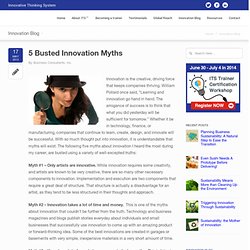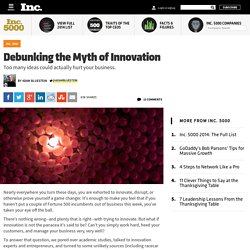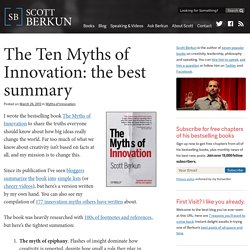

The myths of innovation. Too-Big-To-Innovate Is Not About Innovation. Innovation Zen - Innovation Myths Category. Innovative Thinking System. Innovation is the creative, driving force that keeps companies thriving.

William Pollard once said, “Learning and innovation go hand in hand. The arrogance of success is to think that what you did yesterday will be sufficient for tomorrow.” Whether it be in technology, finance, or manufacturing, companies that continue to learn, create, design, and innovate will be successful. With so much thought put into innovation, it is understandable that myths will exist.
The following five myths about innovation I heard the most during my career, are busted using a variety of well-excepted truths: Myth #1 – Only artists are innovative. Myth #2 – Innovation takes a lot of time and money. Myth #3 – Knowing a lot of people is necessary to be innovative. Myth #4 – Only the boss is innovative.
Ten Innovation Myths - Scott Anthony. By Scott Anthony | 9:42 AM October 28, 2011 Over the past year I’ve shifted my presentation materials so they include mostly pictures and 96 point font.

That’s good for audiences (at least, I think it is), but bad when I get the kind of request that landed in my in-box last week. “I’m doing an innovation update at one of our meetings and I’m hoping you can assist me with some conversation starters,” a senior leader said to one of our clients. “The main point of the presentation is to get the audience thinking proactively and positively about how they can contribute to innovation.” I had presented a slideshow on this exact topic in April. So, my colleague Josh Suskewicz and I put our heads together and came up with the 10 innovation myths that we encounter most often in the field. There’s no doubt we missed something important in our list. . * This is where the slide showing the barber shop example appears.
7 Innovation Myths That Kill Performance. Debunking the Myth of Innovation. Nearly everywhere you turn these days, you are exhorted to innovate, disrupt, or otherwise prove yourself a game changer.

It's enough to make you feel that if you haven't put a couple of Fortune 500 incumbents out of business this week, you've taken your eye off the ball. There's nothing wrong--and plenty that is right--with trying to innovate. But what if innovation is not the panacea it's said to be? Can't you simply work hard, heed your customers, and manage your business very, very well? To answer that question, we pored over academic studies, talked to innovation experts and entrepreneurs, and turned to some unlikely sources (including racecar teams) to get beyond the rhetoric and find the reality behind six of the most common myths about innovation. MYTH: Innovation is disruption. FACT: Small steps are more likely to spur success. Not that much, suggests a 2012 report by innovation consultants Bansi Nagji and Geoff Tuff.
Innovation Myths Debunked. Innovation Myths and the Unsexy Truths About Breakthroughs: How Ideas Really Happen. The Ten Myths of Innovation: the best summary. I wrote the bestselling book The Myths of Innovation to share the truths everyone should know about how big ideas really change the world.

Far too much of what we know about creativity isn’t based on facts at all, and my mission is to change this. Since its publication I’ve seen bloggers summarize the book into simple lists (or cheezy videos), but here’s a version written by my own hand. You can also see my compilation of 177 innovation myths others have written about. The book was heavily researched with 100s of footnotes and references, but here’s the tightest summation: The myth of epiphany. If you liked this summary, please get the book. Top 10 Innovation Myths. Geoffrey A MooreTCG Advisors If you are worrying about innovation, take heart.

Only successful companies do. By contrast, unsuccessful companies either aren’t around to do any worrying or are consumed with more pressing concerns, like meeting payroll or paying their bills. At the other end of the spectrum, venture-backed startups have lots of worries, but innovating isn’t one of them – they actually worry more about not innovating, as in let’s not waste our scarce resources reinventing wheels that others have already developed.
But you are not a startup. You have some success, some momentum, and therefore some inertia, and it is the inertia that has you worried. By design inertia resists change. This is a good thing, as long as you are headed in a direction you want to go. But when the market changes, inertia acts against your future interests. Now you are right to be worried. So you raise the topic of innovation in hopes of getting some insight. 4 Myths About Apple Design, From An Ex-Apple Designer. Apple is synonymous with upper echelon design, but very little is known about the company's design process.

Most of Apple's own employees aren't allowed inside Apple's fabled design studios. So we're left piecing together interviews, or outright speculating about how Apple does it and what it's really like to be a designer at the company. Enter Mark Kawano. Before founding Storehouse, Kawano was a senior designer at Apple for seven years, where he worked on Aperture and iPhoto. Later, Kawano became Apple's User Experience Evangelist, guiding third-party app iOS developers to create software that felt right on Apple's platforms.
In an interview with Co.Design, Kawano spoke frankly about his time at Apple—and especially wanted to address all the myths the industry has about the company and about its people. Myth #1 Apple Has The Best Designers "It's actually the engineering culture, and the way the organization is structured to appreciate and support design.